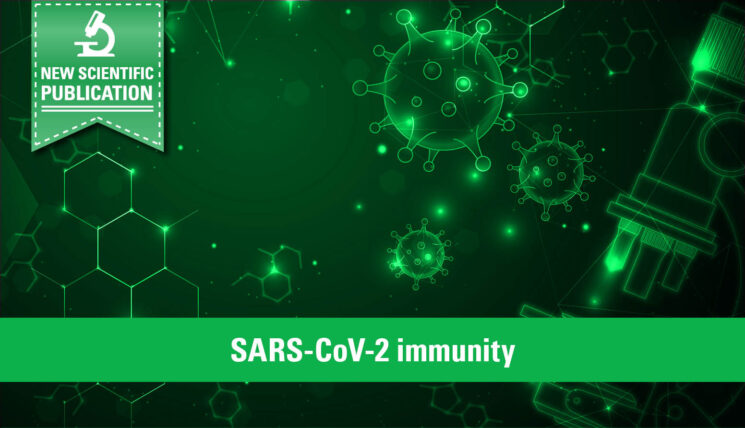Two new studies on SARS-CoV-2 vaccine immune responses suggest that the XBB.1.5-containing mRNA vaccines most likely increase protection against COVID-19 caused by currently circulating XBB variants and the emerging BA.2.86 variant in healthy persons and in patients on haemodialysis. The studies build on collaborative work between the Hannover Medical School, Germany and EUROIMMUN and were both published recently in The Lancet Infectious Diseases.
Adaption of COVID-19 vaccines is required due to the emergence of SARS-CoV-2 omicron lineages that efficiently evade immunity from infection or vaccination. Updated monovalent omicron XBB.1.5 vaccines were approved by regulatory authorities in September 2023 and are applied as boosters in many countries. In December 2023 the WHO advised retaining this composition as COVID-19 vaccine antigen. Manufacturer data suggest neutralisation of currently emerging sublineages, but real-world evidence is scarce.
In the first study, the humoral and cellular immune responses were analysed in healthcare workers both before and 8–10 days after vaccination with the updated BNT162b2 omicron XBB.1.5 vaccine (BioNTech). All study subjects had previously been vaccinated multiple times, including a proportion with bivalent wild-type/BA4/5 vaccines. The majority had also experienced a SARS-CoV-2 infection.
Antibodies against spike (S) protein were measured quantitatively using the EUROIMMUN Anti-SARS-CoV-2 QuantiVac ELISA (IgG), with results expressed in standardised binding antibody units (BAU/ml). Before vaccination, the study subjects showed a mean of 1422 BAU/ml of anti-S IgG antibodies. XBB.1.5 vaccination resulted in a significant 2.9-fold increase in anti-S IgG.
Neutralising antibodies against S proteins of seven different SARS-CoV-2 lineages were analysed using a pseudovirus particle neutralisation assay. At baseline, particles carrying S proteins from XBB sublineages were generally less efficiently neutralised compared with the ancestral B.1 strain. BA.2.86 pseudovirus particles evaded neutralisation less efficiently than XBB particles. After vaccination, there was a significant increase in neutralisation for contemporary SARS-CoV-2 lineages, including XBB.1.5, XBB.1.16, EG.5.1, XBB.2.3 and BA.2.86.
Cellular responses were analysed by measuring the frequencies of S-specific CD4 and CD8 T cells and by quantifying the interferon-gamma (IFN-γ) release of S-specific T cells in whole blood following stimulation with S-based peptides. The latter was performed using the EUROIMMUN Quan-T-Cell System. Before vaccination, frequencies of S-reactive IFN-γ CD4 and CD8 T cells were relatively low. After vaccination, frequencies of wild-type and XBB.1.5 S-responding CD4 T cells and XBB.1.5 S-responding CD8 T cells increased significantly. IFN-γ measurement results after S peptide stimulation showed a significant increase. The T-cell responses were, nevertheless, only slightly above the mean obtained after third vaccination, indicating a robust T cell-mediated immunity layer.
The authors summarised that BNT162b2 XBB.1.5 vaccination strongly increased anti-S IgG antibodies in all vaccinees and elicited potent neutralising responses against previous and contemporary SARS-CoV-2 lineages, including EG.5.1. and BA.2.86.
In the second study, the immune responses of 44 haemodialysis patients were investigated before and after XBB.1.5 booster vaccination. Patients on haemodialysis are at risk of severe SARS-CoV-2 infections and their vaccine responses are both less robust and subside faster. Postvaccination, these patients demonstrated a mean 2.4-fold increase in anti-S IgG, as well as augmented neutralisation responses to contemporary SARS-CoV-2 lineages, in line with findings from healthy controls. A significant increase in IFN-γ release after S-peptide stimulation was also observed, suggesting strengthened T cell responses. The authors conclude that the updated XBB.1.5 vaccine is a critical tool for enhancing protection against evolving SARS-CoV-2 variants in vulnerable populations.
Read the publications about immune responses following BNT162b2 XBB.1.5 vaccination in the journal Lancet Infectious Diseases:
Stankov MV et al. Humoral and cellular immune responses following BNT162b2 XBB.1.5 vaccination. Lancet Infect Dis. 24(1):e1-e3 (2024). doi: 10.1016/S1473-3099(23)00690-4
Cossmann A et al. Immune responses following BNT162b2 XBB.1.5 vaccination in patients on haemodialysis in Germany. Lancet Infect Dis. https://doi.org/10.1016/S1473-3099(23)00783-1
